Rock Xtreme 620 – 15.4in Gaming Notebook Review
Rock Xtreme 620 – 15.4in Gaming Notebook
Rock brings us 15.4 inches of gaming notebook with a touch of class.
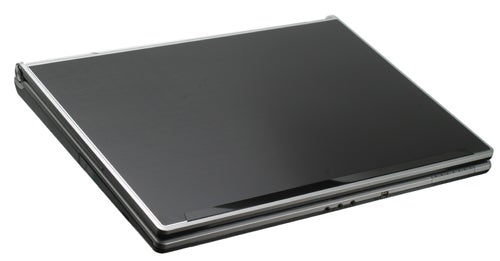
Verdict
Key Specifications
- Review Price: £1762.00
Notebooks seem to be getting smaller and smaller, and it’s a trend that’s even affecting gaming notebooks. A few years ago you would have been hard-pressed to find a gaming notebook with a decent graphics card coming in at under 17in, but Alienware changed this when it released the 15.4in Area-51 m15x last year. Now Rock has its own thoroughbred 15.4in gaming notebook, the Xtreme 620, but can it match Alienware and its gaming behemoth?
Based on Clevo’s M860TU chassis, the X620 gets off to a good start with its stylish brushed metal black lid that’s unspoiled by any logos or patterns. This is accented by a smart silver trim around the edges and a strip of piano black plastic at the top, with chromed hinge caps completing the attractive exterior. 
Inside things look a tad less classy due to the contrast between the matte plastic screen bezel and brushed metal lower section, but at least those who find glossy bezels distracting have nothing to complain about. Unfortunately the screen itself is highly reflective and the webcam also sits in a small glossy surround with the word ‘eyeshot’ beside it. Presumably this is some play on the term ‘headshot’ meant to appeal to a gamer’s sense of humour.
Moving to the main body of the notebook, everything except the touchpad and keyboard is also finished in brushed black metal, offset by the silver trim around the edges, a narrow glossy strip around the keyboard and thin chrome strips accentuating the touchpad. A blue-backlit power button and three shortcut buttons are etched out of the metal, a la Motorola Razr V3, and the speakers are a subtle pincushion pattern to either side of these.
Overall, it’s a subtle and elegant design with far less bling than we’re used to seeing from a gaming notebook, but for many that will be a welcome development. It’s certainly a far cry from the somewhat cheap styling of Rock’s Xtreme 780. 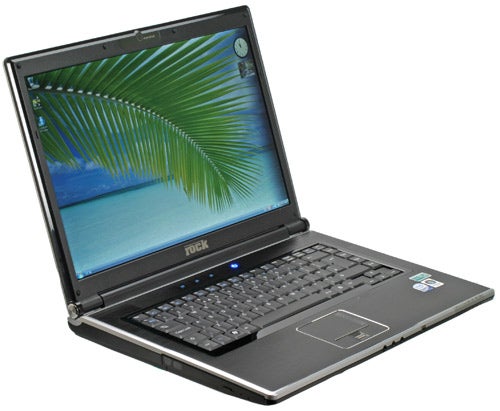
Despite looking fairly unremarkable, the keyboard’s matte finish matches the screen’s bezel nicely. Layout is just as one would want, with Ctrl to the outside of Fn key and a large UK-style Enter key. Cursor-keys are well-separated and full-size, which is nice for split-screen games and the few gamers that still use them primarily, and there are dedicated Home to End keys on the right-hand side.
Keyboard feedback is, in a word, excellent. Keys are broad and comfortable and though some do have a hint of rattle and there’s just the slightest bit of flex, there’s plenty of travel and keys have a positive, springy feel to them.
Below the keyboard, the Xtreme 620’s touchpad is so slightly indented as to look like it’s flush with the rest of the chassis. It’s a plain matte affair, thankfully spurning the garish giant ‘X’ of the X780; the only marking being a subtle pattern of slightly raised miniature white squares demarking the scroll zone. 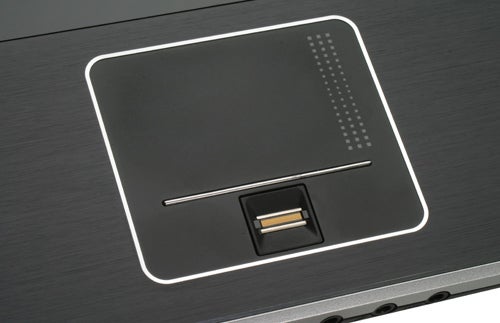
Pad and buttons form a single surface separated only by a thin chrome strip. These buttons aren’t the best as they’re a bit on the stiff side, but neither are they unpleasant to use. Nestled between them is a biometric fingerprint scanner, which can be used as an alternative (or additional) method of securing your precious notebook’s data to the traditional password.
Connectivity is a bit unusual in that there are only two USB ports accessible from the front, though there are a further two at the back. On the X620’s left the Blu-ray ROM and DVD-Rewriter sits all by itself, while the front houses headphone and microphone jacks as well as a mini-FireWire port. This is also where you’ll find the indicator lights, which are visible with the notebook’s lid closed.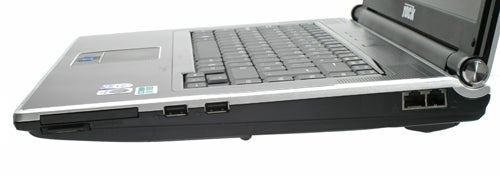
On the right, the aforementioned USB ports, a memory card reader and 54mm ExpressCard slot are joined by the modem and Ethernet ports. Finally, at the back reside the ventilation slot, lock slot, power input and twin digital video connections in the form of one DVI and one HDMI output. Unfortunately, as with the X720 the DVI port is not of the dual-link variety, meaning owners of 30in monitors are left out in the cold. Rock does include a DVI-VGA adapter should you have an analogue-only display, though.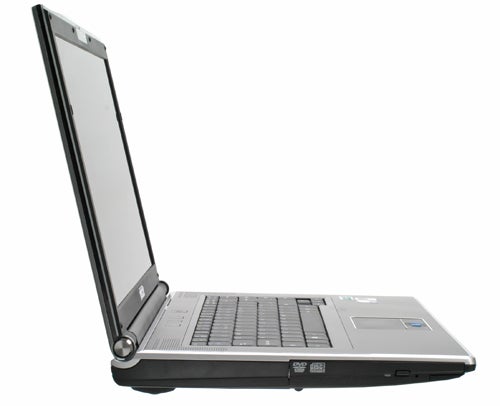
Whereas almost any notebook available today is more than capable of the everyday tasks demanded of it, a gaming notebook needs some serious grunt under the hood. Rock’s Xtreme 620 makes a good start for itself with a speedy Intel Core 2 Duo T9600 processor running at 2.80GHz. This 45nm CPU has a 6MB cache and a 1,066MHz bus speed, which matches that of the 4GB of DDR3 memory provided. This memory is optimally used by a 64-bit version of Windows Vista Home Premium.
Easily the most important component of any gaming machine, though, is its graphics card, since this has far more influence on how games will run than the processor. While not the most powerful card around, an nVidia GeForce 9800M GT with 512MB of video memory strikes a good balance between performance and value. 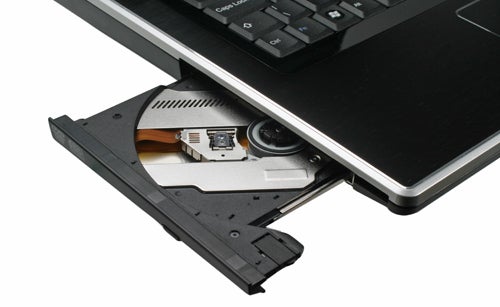
Unlike the 9600 series (often sold in gaming laptops as a supposedly capable card), the 9800 can actually run demanding games without resorting to lower resolutions. At the 15.4in screen’s native 1,680 x 1,050 resolution the X620 managed a perfectly adequate 49.7fps in Call of Duty 4 with details set to maximum and two samples of anti-aliasing.
As usual Crysis was more of a challenge, with High Quality settings under DX10 bringing the average down to an unplayable 17.66fps at native resolution. However, changing this to 1,280 x 800 delivered a mostly smooth experience with an average of 30.7fps and no noticeable loss of quality due to the screen’s good scaling.
Only 250GB of hard drive storage might seem a bit stingy at first, but this is actually one of the fast 7,200rpm drives rather than the 5,400rpm you’d usually encounter in a notebook. For an extra £55 you can upgrade to a 320GB model or even a slower 5,400rpm 500GB one, but for games 7,200rpm is preferable. Last but not least we have a Blu-ray drive, though oddly enough it doesn’t say so on the actual drive cover, claiming support for only DVD and CD.
Even stranger is that Rock hasn’t pre-installed any software that can actually play Blu-ray films. CyberLink’s DVD Suite is on hand for multimedia duties but the included version of PowerDVD lacks Blu-ray support. However, a Blu-ray capable version of WinDVD is included with instructions to install it if you want to view HD discs. Why Rock didn’t just pre-install it is beyond us. It’s also worth keeping in mind that if you don’t need or want Blu-ray playback, you can save £110 by downgrading to a standard DVD-Rewriter.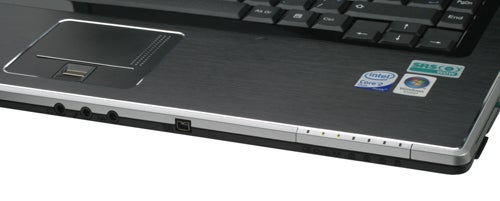
Taking care of wireless duties is an Intel WiFi Link 5300 providing Draft-N support, and Bluetooth 2.1 is also present. Despite all this being stuffed into a smaller chassis than was the case with the 17in Xtreme 780, we’re glad to report the X620 is a far quieter beast: in normal use it’s virtually inaudible, though when gaming the cooling kicks up a notch producing a noticeable whine. Build quality is also much improved, with the slight rattle in the keyboard the only niggle.
If you can get past the reflections or are playing in a darkened environment, the Xtreme 620’s screen is quite good. To get the negatives out of the way, we’ve yet to come across a notebook display other than the amazing RGB-backlit example on the Dell Studio XPS 16 that has really good black detail, with the X620’s 15.4in panel dropping tones on both ends of the greyscale. Another disappointment is that despite the glossy coating colours don’t have the ‘punch’ you’d expect and can appear a bit washed out, though this also avoids the oversaturation that afflicts some notebook displays.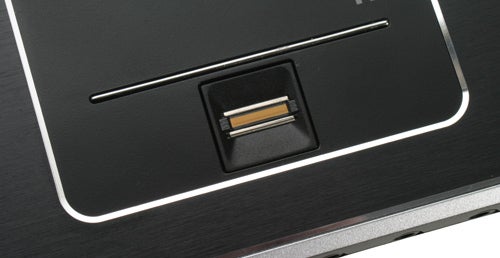
On the positives side, thanks to the high 1,680 x 1,050 resolution everything is razor-sharp and there’s no sign of backlight bleed or banding. Most impressive, though, are the horizontal viewing angles, which while not perfect are certainly superior to what we’ve come to expect from the average notebook panel. Unfortunately, vertical ones are as poor as ever, so you’ll need to position the screen’s angle carefully to get the most out of it.
Audio is another pleasant surprise. Rather than the tinny efforts of most notebooks, the Rock Xtreme 620’s speakers create a reasonably immersive soundstage. Bass comes across with plenty of punch and weight at respectable volume levels without too much distortion or any of the usual muddiness. Treble is also handled well, making this one notebook where headphones or separate speakers are not the necessity they are on most.
In terms of software Rock gives you a very clean Windows install – just the way most gamers will want it. Pre-installed you get BisonCam webcam software and the aforementioned CyberLink DVD Suite v6; Nero 8 Essentials on an included disc rounds out the package.
At this stage it’s also worth mentioning the included laptop bag. It’s as basic as it gets, but a nice addition for those who don’t already own one. It has a padded carrying handle, shoulder pad and inner section, providing some protection for your expensive new gaming notebook while on the move and also storing the system discs and power adapter – itself a large brick weighing over half a kilo. 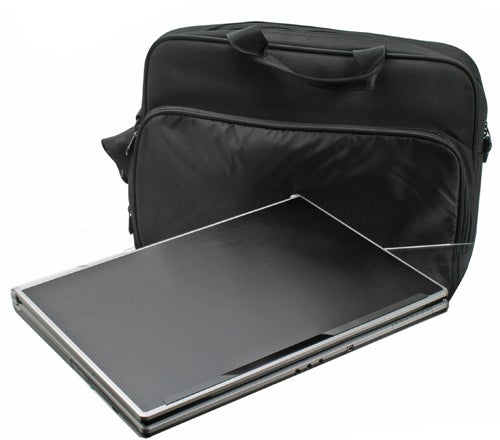
Coming in at 3.3kg (not including the AC-adapter), the X620 is hardly a lightweight, but still relatively portable for a machine this powerful. Despite using an identically-rated six-cell 4,400mAh battery to Novatech’s X50MV 15.4in Pro Gaming Notebook and using a more power-hungry graphics card, the X620 put in a slightly better performance, with two hours and 15 minutes of use in the non-intensive Reader test. 
This dropped to an hour and 36 minutes in the DVD test with the screen at 100 per cent brightness. This is enough for moving around the house but doesn’t give you much flexibility, a fact compounded by the lack an extended battery option.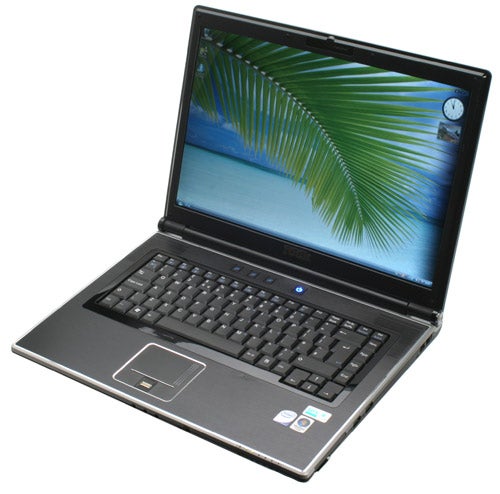
Even so, overall the Rock Xtreme 620 represents good value for money. To put this into context, a similarly-configured Alienware Area 51 m15x (except with a lower-resolution screen and slower 2.6GHz processor) would end up costing £1,986 compared to the £1,762 that lets you take the Rock home. Since games are throttled by the GPU rather than CPU, an even better option would be to go for the Intel 2.53GHz T9400 configuration which, everything else remaining the same, would set you back £1,585. It’s also worth remembering Rock’s very generous standard three year warranty, something that would cost a lot extra from many manufacturers.
Verdict
Rock’s 15.4in gaming notebook outdoes its 17in predecessor in every way and gives other similarly-sized gaming machines a run for their money. It’s well-built and looks the part too, while striking a nice balance between performance and value. Our only real complaint is that it gets somewhat noisy while gaming, but this will probably be drowned out by gunfire and explosions from the impressive speakers.
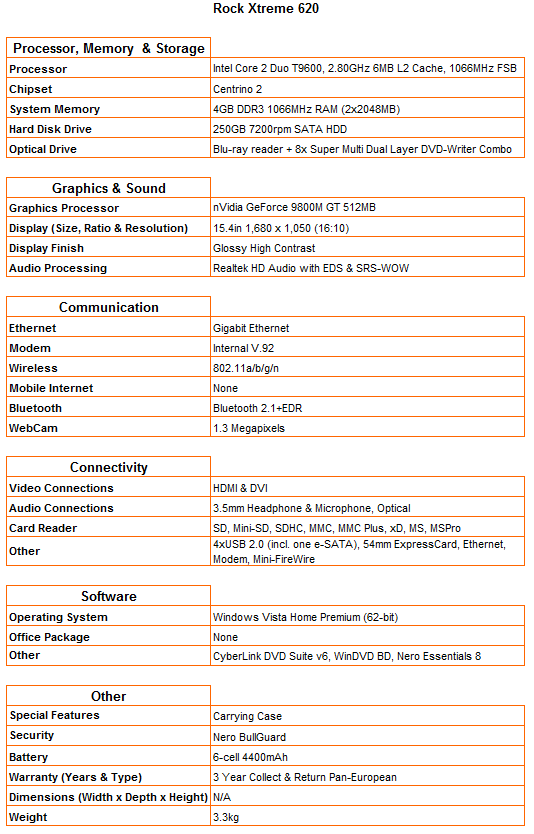
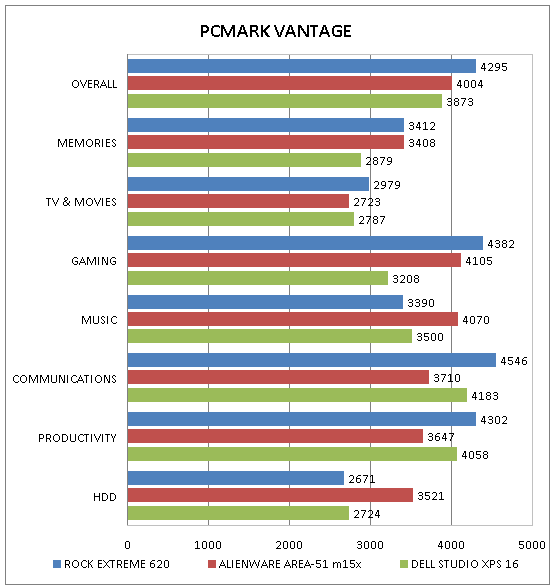
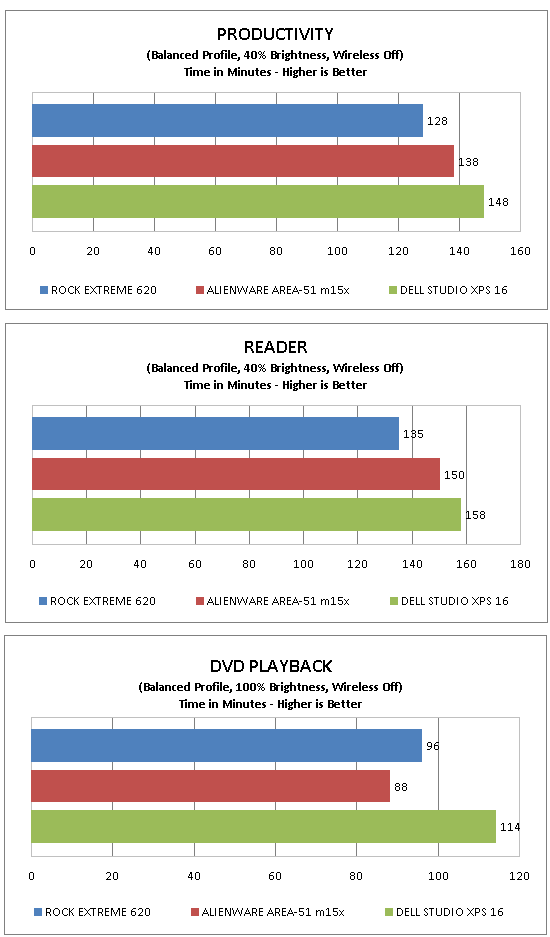
How we test laptops
Unlike other sites, we test every laptop we review thoroughly over an extended period of time. We use industry standard tests to compare features properly. We’ll always tell you what we find. We never, ever, accept money to review a product.
Trusted Score
Score in detail
-
Performance 9
-
Design 8
-
Value 8
-
Features 8

